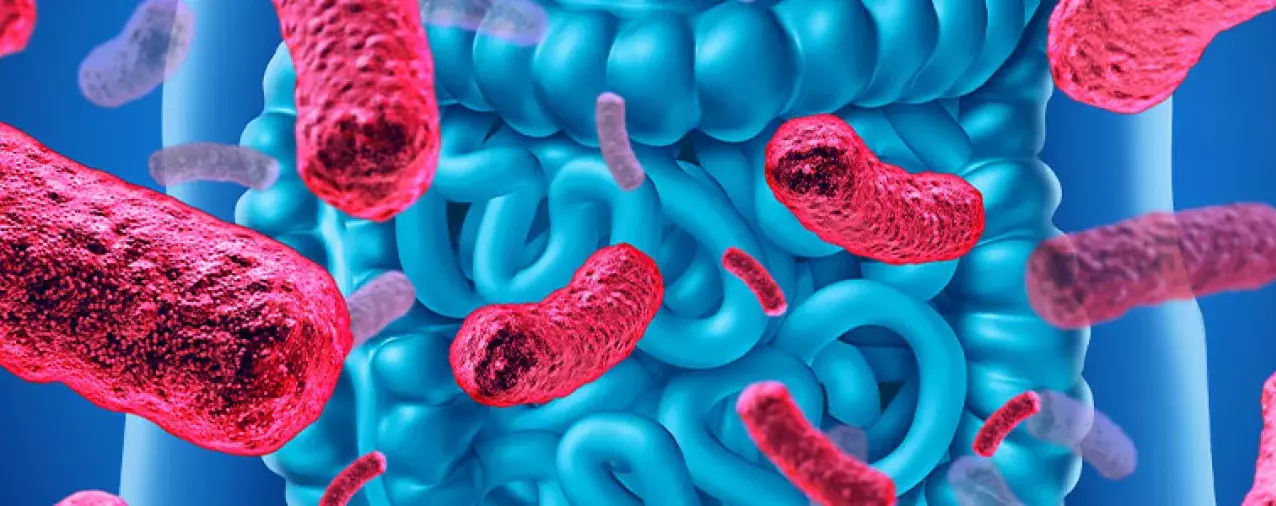Genomics: Insight

Gut Microbiome Modulation for Colorectal Cancer

Colorectal cancer (CRC) is the third most common cancer diagnosis among men and women in the United States.1-3 While cancer is recognized to be a disease of both genetic and environmental factors, growing literature has demonstrated a role of the microbiota in shaping inflammatory environments and promoting tumor growth.4 Microbiota are the microorganisms associated with the human body.
“ CRC arises from […] genetic, epigenetic and environmental aspects. ”
A recent review published this year in Oncogene describes the potential significance of gut microbiota modulation and provides some evidence that it may have a fundamental role in prevention and treatment of CRC.5 Gut microbiota modulation is a novel strategy that aims to reverse microbial imbalance. The authors describe five different strategies for microbiota modulation including its potential benefits and risks for CRC treatment: 1) probiotics, 2) prebiotics, 3) postbiotics, 4) antibiotics, and 5) fecal microbiota transplantation (FMT).
1. Probiotics
Probiotics are live, friendly bacteria that aid the human digestive system. Administration of probiotics may assist in CRC treatment by occupying host tissue and preventing colonization of pathogenic bacteria by resisting colonization, modulating immunity and enhancing gut barrier function.
Colonization resistance: Probiotics may prevent the growth of harmful pathogenic bacteria by releasing proteins that target harmful bacteria and lowering pH in the gastrointestinal tract to make the environment more acidic and uninhabitable. They also compete against pathogens for the same nutrients and location, so that pathogens are unable to survive.
Immunity modulation: Probiotics also modify the response of the immune system either to reduce colonic inflammation or enhance antitumor immunity. In order for probiotics to reduce colonic inflammation, they activate the cells that are responsible to process foreign material in the body; this results in reducing other cells that cause inflammation and activating others that have anti-inflammatory activity. On the other hand, probiotics also have the potential to enhance the anti-tumor immunity, which is a natural mechanism of defense by modulating different cells of the immune system. In consequence, these cascade of reactions in the body reduce the expression of proteins involved in tumor formation.
Enhancement of gut barrier function: Lastly, probiotics may produce tight junction proteins, epithelial cells, and gel-like secretions called mucin. They are all essential to make a strong intestinal mucosal barrier that ensures proper containment of undesirable contents within the intestine while preserving the ability to absorb nutrients.
One of the safety concerns regarding probiotic use is the risk of bacterial translocation, where bacteria from the GI tract may possibly spread to other parts of the body. A second issue is the potential transmission of resistant genes to resident microbiota and the rise of antimicrobial resistance. Antibiotic resistant genes may be detrimental and more difficult to treat as the bacteria would survive the effects of antibiotics that are designed to kill them.
2. Prebiotics
Prebiotics are compounds in food that feed the friendly bacteria in the gut. They may stimulate probiotic growth and produce short-chained fatty acids including acetate, propionate, and butyrate. They also prevent pathogens from attaching to epithelial, or surface, cells of the GI tract. Studies have shown that propionate and acetate may have a role in suppressing colonic inflammation and protecting host against intestinal infection.6,7 Furthermore, prebiotic molecules have antiadhesive properties against pathogens, similar to that of a vaccine designed to block a virus from attaching to the host cells.
3. Postbiotics
Postbiotics are inactivated and immobilized form of probiotics. They may provide selective cytotoxicity against tumor cells and protect intestinal epithelium by inhibiting apoptosis, or cell death, of normal epithelial cells and secreting Immunoglobulin A, which is an antibody that plays a crucial role in the immune function of mucous membranes. Interestingly, it may be a safer alternative when compared to the intake of active forms of microorganisms.8 Moreover, safety concerns regarding prebiotics and postbiotics have not been reported.
4. Antibiotics
Antibiotics are promising approaches to reverse large microbiota imbalance and restore homeostasis. Antibiotics are medicines that help stop infections caused by bacteria. Antibiotics may directly kill harmful pathogenic bacteria. Nonetheless, a safety concern is that antibiotics have non-selective antimicrobial activities which may lead to another state of dysbiosis by killing the harmless commensal microflora that regulates anticancer activity.
5. Fecal microbiota transplantation (FMT)
FMT is a fecal preparation from a carefully screened, healthy stool donor that is transplanted into the colon of a sick patient in effort to repopulate their microbiome with diverse microorganisms. However, it may carry the risk of transmitting pathogens or disease-causing genes from outside sources to the recipient, which is another concern that needs to be considered before appropriate use.
“ Developing personalized microbiome therapy may be the key to successful clinical treatment. ”
In summary, the published review briefly discussed above provides a general logic of how gut microbiome modulation strategies may healthily maintain the gut floral environment and ultimately treat CRC. While the theoretical framework of the microbiota genetic functions and molecular pathways has been established, its direct clinical effect on CRC requires further research in animal and human trials. A few recent studies seem to be promising, they have implemented gut microbiota manipulation in in vitro mice models resulting in the downregulation of inflammation and reduction of genotoxin (a poisonous substance that damages DNA) exposure, which are both plausible mechanisms for CRC protection.9 It would be exciting to see personalized microbiome therapy implemented in clinical practice in the near future.
References
- Thanikachalam K, Khan G. Colorectal Cancer and Nutrition. Nutrients. 2019;11(1):164. Published 2019 Jan 14. doi:10.3390/nu11010164
- Mármol I, Sánchez-de-Diego C, Pradilla Dieste A, Cerrada E, Rodriguez Yoldi MJ. Colorectal Carcinoma: A General Overview and Future Perspectives in Colorectal Cancer. Int J Mol Sci. 2017;18(1):197. Published 2017 Jan 19. doi:10.3390/ijms18010197
- Amersi F, Agustin M, Ko CY. Colorectal cancer: epidemiology, risk factors, and health services. Clin Colon Rectal Surg. 2005;18(3):133‐140. doi:10.1055/s-2005-916274
- Brennan CA, Garrett WS. Gut Microbiota, Inflammation, and Colorectal Cancer. Annu Rev Microbiol. 2016;70:395-411. doi:10.1146/annurev-micro-102215-095513
- Fong W, Li Q, Yu J. Gut microbiota modulation: a novel strategy for prevention and treatment of colorectal cancer. Oncogene. 2020;39(26):4925-4943. doi:10.1038/s41388-020-1341-1
- Tong LC, Wang Y, Wang ZB, et al. Propionate Ameliorates Dextran Sodium Sulfate-Induced Colitis by Improving Intestinal Barrier Function and Reducing Inflammation and Oxidative Stress. Front Pharmacol. 2016;7:253. Published 2016 Aug 15. doi:10.3389/fphar.2016.00253
- Fukuda S, Toh H, Hase K, et al. Bifidobacteria can protect from enteropathogenic infection through production of acetate. Nature. 2011;469(7331):543-547. doi:10.1038/nature09646
- Konstantinov SR, Kuipers EJ, Peppelenbosch MP. Functional genomic analyses of the gut microbiota for CRC screening. Nat Rev Gastroenterol Hepatol. 2013;10(12):741-745. doi:10.1038/nrgastro.2013.178
- Rafter J, Bennett M, Caderni G, et al. Dietary synbiotics reduce cancer risk factors in polypectomized and colon cancer patients. Am J Clin Nutr. 2007;85(2):488-496. doi:10.1093/ajcn/85.2.488
About the Author

Reuben Park is a fourth-year undergraduate student majoring in public health at the Johns Hopkins University. He is pursuing his research interests in colorectal cancer and geriatric screening and treatments.